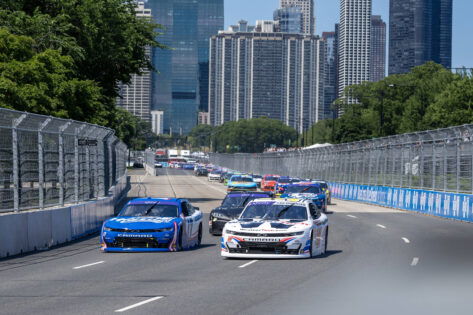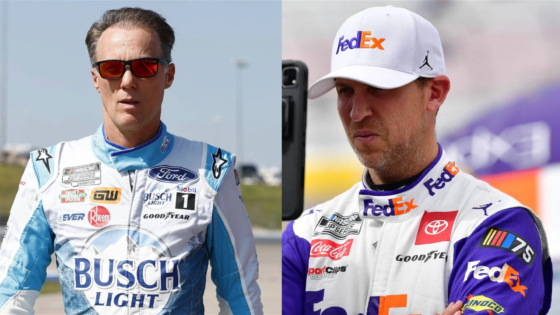Back in 2017, there were just two road courses in NASCAR. Sonoma on the West Coast and Watkins Glen on the East. However, more road courses were slowly added. 2018 saw three, with the addition of the Charlotte Roval. But still, it felt like a special occasion when the Cup cars turned right. There were even times when fans asked for more of these twists and turns. However, it all changed in 2021, when NASCAR jumped from 2 to 7 road courses in one year!
Since then, 5-7 road course races have been a mainstay on the NASCAR calendar. From Chicago’s street chaos to Mexico City’s debut in 2025, NASCAR is leaning hard into left-and-right action. For some fans, it’s a refreshing twist. For others, it feels like stock car sacrilege. So here we are, smack in the middle of a fiery debate. Has NASCAR finally gone overboard with the road courses?
NASCAR’s road-course boom and reality check
Just a week ago, the NASCAR world watched Shane van Gisbergen (SVG) put on a clinic in the Windy City. SVG swept both the Xfinity and Cup Series races on the Chicago Street Course, starting from the pole and dominating the weekend with precision and poise. His Cup victory marked his third career win in just 33 starts. Two years after his debut win at the Chicago Street Course, the buzz around SVG’s street course prowess has only intensified as he continues to prove himself against NASCAR’s best.
Now, the Cup Series heads straight from one road course to another: Sonoma Raceway. Known for its technical 12-turn layout and dramatic elevation changes, Sonoma remains a favorite among drivers and fans who appreciate the unique challenge it presents. But that’s just the start. The 2025 schedule features a robust slate of road and street courses. This includes the Circuit of the Americas (COTA), Watkins Glen, the Charlotte ROVAL, the new Mexico City event, and, of course, Chicago.
With a possible San Diego street race on the horizon for 2026, the trend is clear. Road courses are no longer a novelty; they’re a fixture. But is NASCAR going too far? Some fans and industry insiders are raising eyebrows as the series leans harder into road racing. One concern is declining TV viewership. Through 21 races in 2025, NASCAR’s total audience is down 8.4% from last year.
Through road course races (and streaming platforms like Amazon Prime Video), NASCAR is looking to attract a younger demographic to engage with the sport’s evolving identity. Having all the races on ovals, which already has a stereotype of ‘they just turn left,’ is probably not a good idea to get new viewers. Then, as NASCAR is looking to add more venues, nobody is building new oval tracks, and while revisiting old locations is always open, the sport wants to go bold and new. So, the only way to expand to new markets is by integrating already available road/street courses.
Finally, NASCAR’s leadership, especially Ben Kennedy, argues that diversity helps the sport expand internationally, as he looks to revive Bill France Jr.’s legacy. The recent Mexico City race and plans for further global growth are seen as key strategies to capture new audiences and compete with Formula 1’s global appeal.
So, is NASCAR overdoing it with the road courses, or is this just the evolution the sport needs to thrive in a changing world? As the series barrels toward Sonoma and beyond, the debate is wide open. And the answer may depend on which side of the fence you sit.
Road courses split the NASCAR field
The surge of road and street courses on NASCAR’s calendar has sparked a clear divide within the Cup Series garage. Well, it has pitted established veterans against a new generation of drivers who thrive on these technical layouts. Suddenly, the debate over their place in stock car racing has never been more intense.
On one side, seasoned stars like Brad Keselowski and Denny Hamlin are openly critical of the shift. Keselowski recently stated, “We went from 2 to 6 road course races, possibly 7 next year. NASCAR was successfully built as a primarily oval racing series. Yes, TOO many road courses in NASCAR.” Denny Hamlin shared similar feelings, “I’m not a road course fan. I still believe we have too many of them on the schedule. Six is a lot, considering that we are NASCAR.”
Meanwhile, a wave of younger drivers and international newcomers are embracing the change. Foreign veterans such as Shane van Gisbergen have quickly become road course specialists, racking up wins and challenging the established order. Meanwhile, young studs like Tyler Reddick are proving that road course racing is a necessary skill to survive in the Cup Series. This has rewritten the driver playbook, with adaptability and precision now as valuable as raw oval speed. On track, the results speak for themselves.
Veterans who once dominated on ovals now find themselves outpaced by rookies and younger drivers on road courses. Some veterans are even missing from the recent ‘best road course drivers’ list entirely. For instance, a driver like Kyle Busch, who once dominated Sonoma and Watkins Glen, is absent. This ‘divide’ has fueled frustration and furthered the generational split.
The debate is now about more than just race formats. It’s about what it truly means to be great in modern NASCAR, and whether the sport’s future should be shaped by its past or its next generation. What are your thoughts on road course racing in NASCAR? Let us know in the comments!
The post Is NASCAR Really Overdoing It With the Road Courses? appeared first on EssentiallySports.



